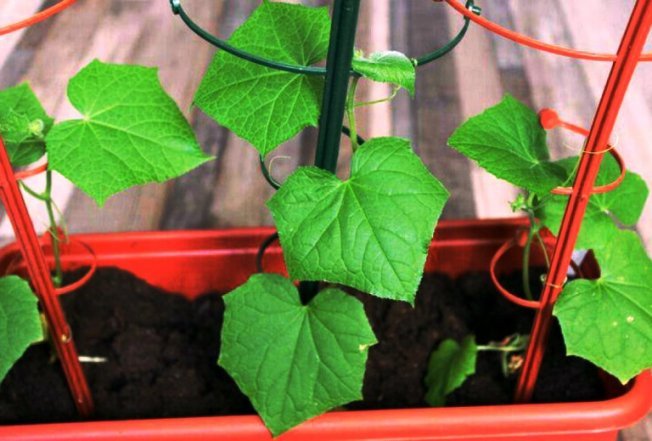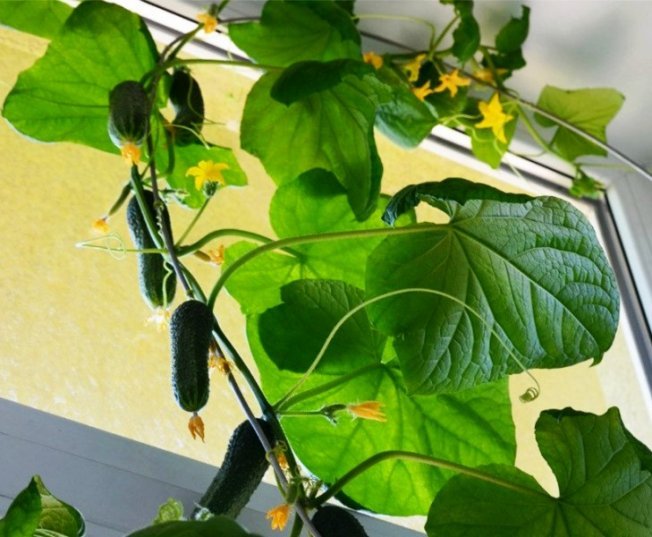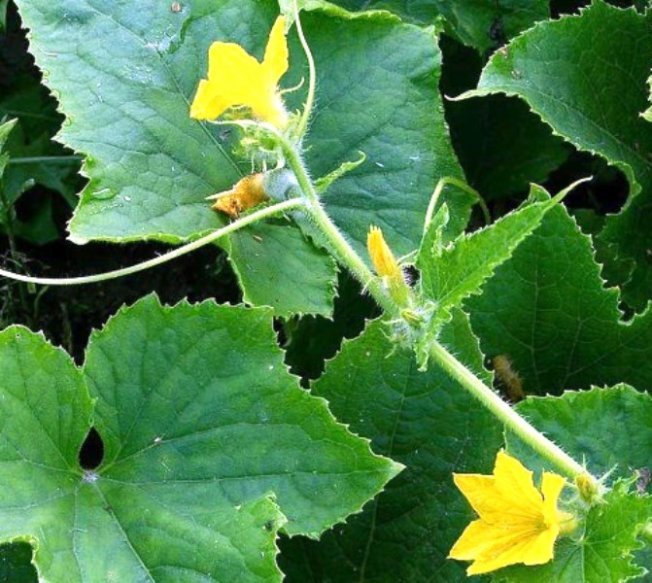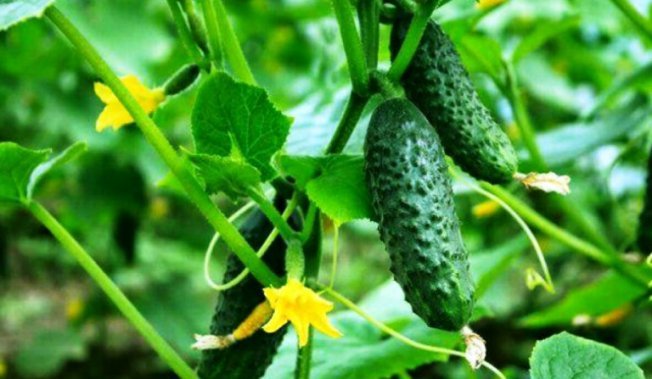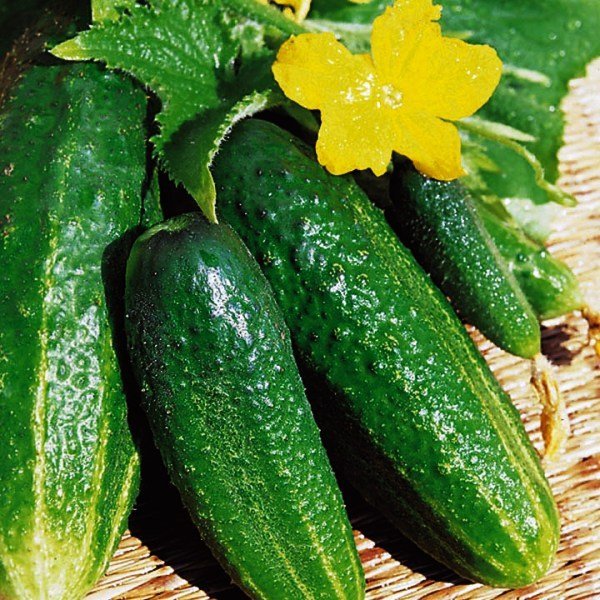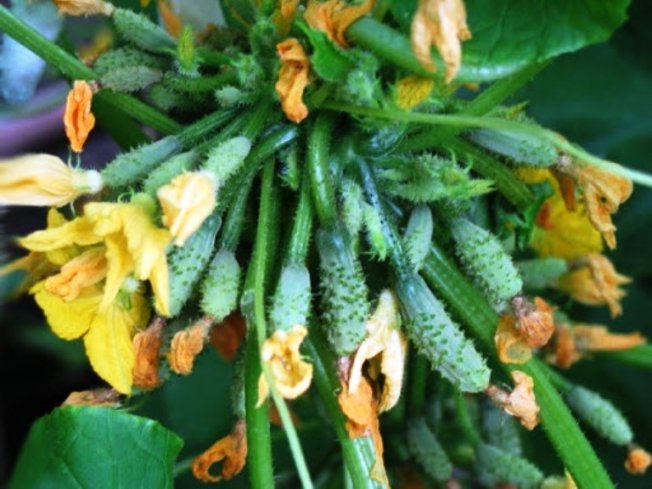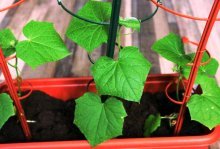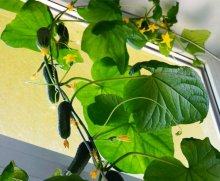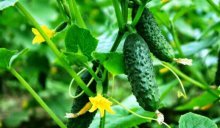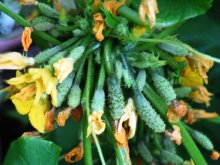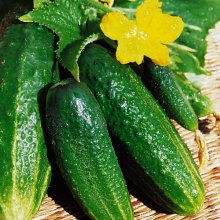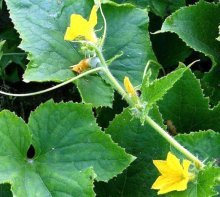Cucumbers on the windowsill for beginners, in spring, at home, planting and care

You can grow vegetables not only on a country plot; those who like to experiment can get a harvest even in an ordinary city apartment. For example, it will not be so difficult to grow cucumbers on a windowsill at home; for beginners in the spring it is somewhat easier to do this, but careful study of the recommendations will allow you to obtain fresh vegetables throughout the year.
Content:
- Are special conditions needed?
- What are the optimal times for sowing seeds?
- Which varieties to choose for growing indoors
- Where to place containers with plants
- What temperature will need to be maintained in the room?
- What containers to use for planting
- How to prepare the soil
- Do I need to prepare the seeds?
- How to sow correctly
- how to water the bushes, what water to use
- What to feed and how often
- Will it be necessary to form bushes?
- Early harvest or long-term fruiting, which is better?
- Will cucumbers bear fruit without pollination?
- What problems do beginners most often encounter when growing cucumbers on a windowsill in the spring? Is it possible to warn them?
Are special conditions needed?
So that the idea with growing cucumbers To succeed, you will need to first familiarize yourself with the technology of the process and take into account useful tips from experienced vegetable growers.
In principle, everything is done in the same way as in greenhouse conditions or open ground. But there are some peculiarities, most of them are associated with the need to create certain conditions that provide the plant with vital illumination, humidity, and daylight hours.
What is the optimal time for sowing seeds?
You can grow cucumbers throughout the year, but only if it is possible to provide high-quality artificial lighting. Winter plantings will definitely require additional lighting.
It is best to sow cucumbers in the spring, when daylight hours increase; if there are many sunny days in the area where you live, then it is likely that you will be able to get a harvest without additional lighting.
More specifically, the optimal time for spring sowing is mid-February - March.
Which varieties to choose for growing in an apartment?
To obtain cucumbers on the windowsill in the spring, for beginners and vegetable growers with no experience yet, it is very important to choose suitable varieties. It is best to pay attention to early or super early, parthenocarpic hybrids, i.e. those that do not require pollination.
The store can also offer varieties designed specifically for growing on the balcony or indoors. The packaging of these varieties indicates that they are suitable for growing in apartment conditions.
For clarity, we will compile a table with the most suitable varieties. We indicate the names in alphabetical order; the place in the list does not relate to the popularity or prevalence of the variety.
| Variety name | Main features | Fruit length in cm |
| Balcony F1 | High-yielding, well branched | 10 |
| Balcony crunch F1 | Not prone to bitterness, there are no voids inside the fruit | 10 |
| Balcony miracle F1 | Branching is weak, growth is average | 8-10 |
| City cucumber F1 | Active branching, tall | 9-12 |
| Homemade miracle F1 | Compact bush | 7-9 |
| Homebody F1 | Not prone to bitterness | up to 14 cm |
| Indoor F1 | Compact bush, small growth | 6-9 |
| Indoor miracle F1 | With proper care, you can get up to 40 greens from the bush | 6-10 |
| Window-balcony F1 | Climbing degree is average | 14-16 |
| Miracle on the window F1 | Cucumber without bitterness | 6-8 |
| Showcase F1 | Weak branching, short side shoots | 8-10 |
| Berendey F1 | Without bitterness | 12-14 |
| Dynamite F1 | Tall, not prone to bitterness | 12-14 |
| F1 calendar | Medium branching, short internodes | 8-10 |
| Hummingbird F1 | Poor branching, short side shoots | 5-8 |
| Swallowtail F1 | The main stem is long, branching is weak, internodes are short | 7-11 |
| Stuntman F1 | The plant is compact, the vines are short, the leaves are small | 8-10 |
A little trick to help you: you can look for varieties whose descriptions indicate that they are shade-tolerant, because in any case, even if the plants are on the balcony, the lighting level will be lower than in open ground conditions.
Where is the best place to place containers with plants?
The location for containers can be:
- a window sill facing the south or west side of the house;
- insulated, heated balcony or loggia.
On the balcony, containers with cucumbers can be placed in the most remote corner; be sure to place a sheet of foam plastic under the containers; for cucumbers, it is important that the roots are kept warm; it is recommended to attach reflective foil to the walls.
If there is reason to believe that the plant will not have enough light, then it is advisable to consider the option of organizing high-quality lighting. The same goes with the heating system if it’s cool in the apartment or on the balcony.On windows with old frames, all cracks should be sealed - cucumbers do not tolerate drafts.
If you are considering the option of growing on northern windows or balconies, then you must take into account that lighting will be required; even shade-tolerant varieties will not be able to bear fruit normally in such conditions.
Daylight hours for cucumbers should be from 12 to 16 hours!
For illumination, you can use conventional, or even better, full-spectrum LED lamps. The distance from the lighting fixtures to the plant should be from 5 to 15 cm. The lamps will need to be turned on not only in the evening, but also in the morning, for example, daylight hours can begin at 7 am and last until 11 pm.
What temperature will need to be maintained?
It is best if the room temperature throughout the day fluctuates between +20 +25 C. It is undesirable for it to drop below +17 C or exceed +30 C.
It is also important to protect plants from drafts; sudden changes in day and night temperatures should not be allowed.
What containers should I use for planting?
For planting cucumbers, it is recommended to use wide containers, it does not really matter what material they are made of, it can be balcony boxes or plastic pots or buckets. It is important that the container has a volume of at least 5 liters, how much soil is required for the full development of roots. Since the root system is located vertically, it is advisable to choose wide containers.
You should not plant two or more plants in one pot; competition for food will lead to a slowdown in development and growth, and the green mass of the bushes will increase slowly.
Containers must have drainage holes for excess water.
Modern technologies also offer the option of growing cucumbers in bags. Holes are made in polyethylene:
- from above - for watering and fertilizing;
- from below - to remove excess liquid.
The bags are placed in a container into which the water will drain.
Let's watch an interesting video about growing cucumbers at home in bags:
Beginning vegetable growers will be interested to know that cucumbers on a windowsill in the spring can be grown in seedlings and without seedlings, just like in garden beds.
It is equally important to remember that plants are sensitive to root damage, so they will need to be replanted with the utmost care. Transplantation to a permanent place in a large container is carried out after the appearance of 2 or 3 true leaves.
How to prepare the soil?
For planting, you will need to prepare a fertile, loose soil mixture; it should easily allow air and moisture to pass through. It is fashionable to use a universal substrate for indoor flowers, which is sold in stores, or soil intended for pumpkin crops.
You can prepare a suitable mixture yourself from peat, humus, vermiculite, wood ash, and river sand. All components are thoroughly mixed, the resulting substrate is heated in the oven, then spilled with solutions of potassium permanganate or Fitosporin.
Do I need to prepare the seeds?
Yes, if they are not processed by the manufacturers. It is not difficult to recognize this by the appearance of the seeds: the processed seed is painted in bright colors or covered with colored glaze.
If the seeds are not processed, they are pre-soaked in a pink solution of potassium permanganate for about 20 minutes.For disinfection purposes, you can soak the seeds for half an hour in a solution prepared from the juice of 1 clove of garlic and 300 g of water.
Seeds can also be germinated by placing them between layers of well-moistened linen. For several days, keep at a temperature of +25 C +28 C, preventing the napkin from drying out. After the roots appear, the seeds are sown in the ground.
How to sow correctly?
After laying the drainage layer (pebbles, expanded clay or pieces of foam), the container is filled with soil about 2/3. This will later allow you to add more substrate. The plant will have the opportunity to grow additional roots, which will have a positive effect on the speed of development of the root system and the bush itself.
Before planting, the soil is shed with warm, settled water. It is recommended to deepen the seeds into the soil by one and a half to two centimeters.
If possible, sow at least 2 seeds in each pot - as they grow, you can remove the weaker plant.
Each bush will require 5 liters of soil; if cucumbers are planted in large containers, then the distance between the plants should be at least 35 cm.
The seeds are sprinkled with soil and watered. The containers are covered with polyethylene or glass to create “greenhouse conditions”.
Until the shoots emerge, the containers can be kept in a dark place with a temperature of +25... +27 C.
After emergence of shoots, the slides are transferred to a well-lit room with a temperature within + 20...+ 23 C.
How often to water the bushes, what kind of water to use?
Water the cucumbers in the morning so that the soil should dry out by evening. Why? At night the temperature drops, dry soil cools more slowly.
You can spray water near plants only in the morning.This procedure can be carried out both in summer and winter: plants located near heating devices suffer from too dry air.
Watering must be done carefully, otherwise there is a risk of exposing the roots.
Water the cucumbers with warm water, the temperature of which should be equal to the air temperature in the room.
What should I feed the plants with and how often?
When growing cucumbers at home, fertilizing is carried out more often than in garden beds.
During the period of active growth, before flowering, plants require more nitrogen. During the flowering period, the bushes are fed with nitrogen-potassium fertilizers. To increase the number of ovaries, the plant can be sprayed with a solution of boric acid.
With the beginning of fruiting, the composition of the fertilizer changes, the plants require more potassium, nitrogen and phosphorus lose their relevance during this period.
Fertilizers are applied to the soil, but sometimes foliar feeding can be used.
For fertilizing, you can also use complex fertilizers: Agricola, Fertika Lux, or others intended for cucumbers, squash, and zucchini.
Supporters of natural farming can use vermicompost, humate, and chicken manure tincture.
Will it be necessary to form bushes?
Definitely yes. The main stem of a non-parthenocarpic variety needs to be pinched at the level of 5 or 6 leaves, this will make the bush acquire fullness.
If the variety is parthenocarpic, then the bush is formed into one stem; when it reaches the ceiling, you will need to pinch the top.
Experienced vegetable growers recommend trimming the mustaches as they appear: a large amount of nutrients is used for their development, and ultimately the plant loses the opportunity to fully develop.
Of course, in this case you will need to carefully tie the cucumbers to the supports. It is also advisable to tie each lash to a trellis or a stretched rope.
Let's watch a useful video on how to grow cucumbers on a windowsill, useful tips for beginners, and features of caring for plants in spring and winter, at home:
Early harvest or long-term fruiting, which is better?
To get an early harvest, you can remove all the top ovaries; the fewer of them you leave, the faster you will be able to harvest the first harvest. But earlier, the beginning of fruiting may result in the fact that all the ovaries that appear after the first harvest will turn yellow and crumble. The reason for this is a stop in the development of the root system; weak roots are unable to provide adequate nutrition to the bush.
But if you want the bush to bear fruit actively and for a long time, then:
- remove all ovaries up to 5 leaves;
- pick off the first flowers before they form ovaries;
- wait until the plants form a strong root system and form strong lashes.
Only after this can the plants be allowed to form ovaries; you will be pleased that they will form en masse, along the entire length of the vines.
Will cucumbers bear fruit without pollination?
Since parthenocarpic varieties are recommended for growing indoors, the lack of pollination should not affect yield.
If you notice that a lot of ovaries are falling off, then you will need to do artificial pollination of flowers. This can be done with a soft brush or powder puff.
Having chosen a male flower, which is called a barren flower, dip the brush in the pollen on it, then walk the brush inside the female flower.It is not difficult to recognize it by the ovaries that form along with the appearance of the bud, in its lower part.
What problems do beginners most often encounter when growing cucumbers on a windowsill in the spring? Is it possible to warn them?
Since in the spring-winter period the day is short and the illumination is not always carried out correctly, stretching of the stems may be observed. The situation can be partially corrected by adding a little soil into the pots; the procedure can be repeated 2 or 3 times a month.
Due to increased air temperature, the lower leaves may dry out, but the cause may also be insufficiently high air humidity.
Yellowing of the lower leaves is a signal that the plant requires complex feeding.
To combat insect pests, and the possibility of their occurrence cannot be excluded, even in indoor conditions, you can use biological products Bitoxibacillin or Fitoverm, or products prepared according to folk recipes. The most affected old leaves should be removed.
At the slightest suspicion of symptoms of a fungal infection, you should spill the earthen mixture in pots with Fitosporin.
If cucumbers begin to acquire a bitter taste, it means that the conditions for growing them are not entirely favorable. This problem can be avoided by choosing varieties for planting whose description indicates that they are not genetically prone to bitterness.
Growing greens should be harvested in a timely manner; by picking them, you give the next fruits the opportunity to grow more actively.
As for yield: with good care and suitable conditions, a harvest from several bushes can completely provide a family with fresh vegetables.Of course, you shouldn’t count on canning cucumbers in the winter, but you also won’t have to buy greens at the market for salads.

